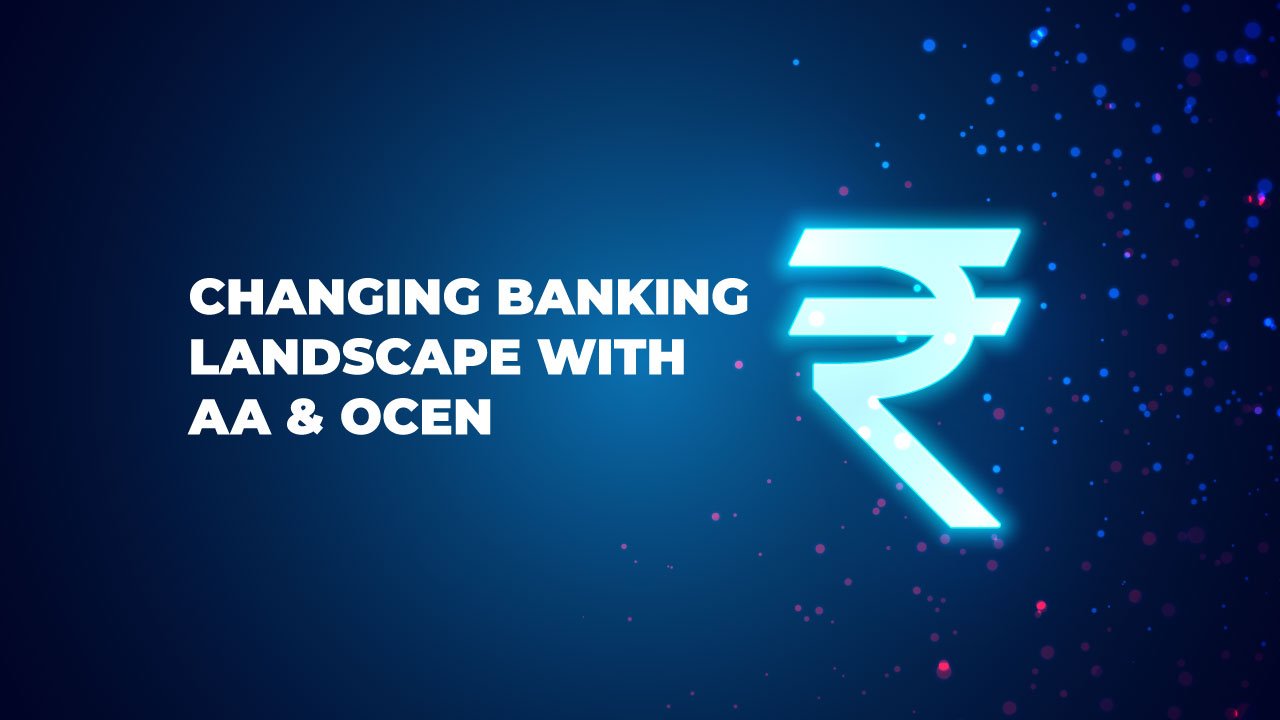Changing the Banking Landscape with AA and OCEN

Last Updated: 13th March 2023 - 12:59 pm
UPI’s remarkable success on payments has put the limelight on progress being made on the next two frontiers:
(1) Account Aggregator (AA) which is the data-sharing layer
(2) open credit enablement network (‘OCEN’) which is the credit layer.
This initiative is still in its nascent stages, but it is likely to create a great impact in the underpenetrated segments of retail and MSME lending. At full-scale, with a decline in the unit cost of credit delivery and improving the viability of lower ticket size loans, new models will be emerging. Standardized and open-source nature will mean new entrants can compete with large banks, whereas large banks can break into a segment that was until now was seen as unattractive due to lower ticket sizes and/or lack of comfort on underwriting. The real impact of AA/OCEN is hard to analyze given the factors involved such as user willingness to share data, the ability of service providers to incentivize adoption, the competitive response from incumbents and new entrants.
India’s AA design philosophy is different from open banking initiatives in other countries in a few ways: (1) the consent manager (AA) is neutral and independent of data receiver or data provider, (2) AA aggregates critical classes of data under one umbrella, viz., banking, investment, insurance, retirement funds, and GST. AA is designed to give a lot of flexibility to users with respect to their data. The initial data in terms of user sign-ups and usage (consent requests) is tracking well, despite the seeming lack of focus on customer awareness due to insufficient use cases and gradual onboarding of FIPs (Financial Information Providers).
Account aggregator (AA) framework and related developments:
- Progress on FIP onboarding: There are about five account aggregator service providers which have launched operations. There are 24 entities living on AA and another 100 in various stages of development. Currently, we have large banks and NBFCs live as mutual fund/ insurance/ GST data is not linked yet. Financial information users (FIU) and the financial information provider (FIP) are the other two central entities participating in the AA ecosystem.
- Progress on user adoption: Initial data on sign-ups suggests about 160 thousand bank accounts have been linked to at least one of the AAs. The actual number of users who have signed up for AA is likely quite lower, a similar number of consent requests processed so far. This is still early days given that some of the large banks (like SBI and BoB) are yet to go live and most of the non-bank data is yet to be made available.
- Process of user onboarding on AA: The adoption of AA will likely happen in two ways: (1) user-initiated sign-up through mobile app download and linking their accounts or (2) During the process of service delivery, FIU will request consent to fetch data from AA and if the user is not signed up, then a profile would get created on the fly.
- Flexibility and privacy of the user: As per regulatory requirements, conversations between a user and AA are fully private and the bank has no visibility. RBI has designed AA differently from others. The customer is truly the owner of the data. A user can choose to reveal to FIP/AA only part of his financial data – e.g. linking only one out of the many savings accounts or sharing data of only one bank a/c with the FIP. The customer also has the ability to revoke approval at any time by accessing his VUA (virtual user account) with the concerning AA. Further, AA itself is data blind with no authority to save the data. All participants of AA are only the custodians and not owners of user and user data.
- Veiled identity of FIU: One of the interesting aspects of AA is that once a data request is sent by an FIU (say HDFC Bank) to AA, the FIP (say SBI) will not be able to see the identity of the FIU. It is designed this way to create a healthy environment for data sharing among the participants.
- Role of Technical Service Providers (TSPs) in FIP/ FIU onboarding: It is important for a FIP and FIU to be integrated with all AAs because the end customer could choose to hold a virtual user account (VUA) with any one of the AAs. Driven by this imperative, the emergence of another class of players called AA TSPs is seen in the ecosystem. TSPs will facilitate the onboarding of FIPs and FIUs onto the AA ecosystem. This will ensure that a FIP/ FIU is not required to separately integrate with each one of the AAs; instead, the FIP/ FIU could simply integrate with one of the TSPs who will onboard the FIP/ FIU onto each of the AAs for a fee.
- The revenue model of AAs: The revenue model for an AA seems to be evolving. There could be multiple potential ways of generating revenues. One of the primary ways seems to be: to charge the FIU for every fulfilled consent request. Some of the companies with an AA license have set up a TSP business alongside the AA business as an additional source of revenue. Also, note that a FIP can potentially look to charge the AA as a means of recovering system costs incurred in enabling data sharing.
Open Credit Enablement Network (OCEN):
OCEN’s foundational principle of democratizing credit has a strong logical and intuitive appeal given that it is focused on one of the most challenging segments of cash-flow-based business loans. It can potentially solve the problems around the cost of acquisition, underwriting, monitoring, and collections. This lead to the entry opportunity to new players, it is indicated that large incumbents have shown slower progress, likely driven by two reasons: (1) large banks have greater reluctance to lend small-ticket, short-duration loans to self-employed segment as risk-reward may not be attractive for large balance sheets; (2) large banks also take a longer time to implement integrations due to policy changes and approvals needed internally. OCEN is currently live on the Government e-Marketplace (GeM) platform through a purchase order finance product (Sahay GeM) with a few active lenders. The OCEN implementation for Sahay GST is in progress.
- OCEN is the fourth part of the India Stack framework, following Aadhar (identity), UPI (payment), and AA (data sharing). OCEN essentially builds standardized data sharing layer between marketplaces or platforms (referred to as LSPs i.e. Loan Service Providers) that generate data and lenders that can capitalize on this data to offer cash-flow-based credit products.
- The core problem that OCEN solves is the creation of protocols that eliminate multiple 1X1 integrations between LSPs and lenders. The team at iSPIRT is attempting to create an OCEN gateway that will have all LSPs on one side and lenders on the other. By simply integrating with the OCEN gateway, an LSP could get connected to all lenders.
- At a system level, OCEN can potentially solve for identification and acquisition cost of customers due to integration with marketplaces. Turn-around times can fall given technology integration, data standardization, payment authorizations, repayment mandates, etc. being handled by OCEN-defined protocols.
- One way to appreciate the potential role of OCEN for MSME lending is to think of it as a critical third source of (high-frequency) non-financial data that builds on top of traditional financial data from credit bureaus/bank statements and other non-credit financial data which will be made available through the account aggregators.
- CredAll is a non-profit entity that is driving the adoption of standardized APIs. CredAll works with a similar purpose as Sahamati for the AA ecosystem. Their objective is to establish proof of concept for OCEN and build foundations that can then be scaled up by the participation of more private players.
AA (Account Aggregator) and OCEN (Open Credit Enablement Network) show a strong potential impact due to its infrastructure, though the use cases being built today are still in their infancy. Adoption rate similar to UPI can help scale the product, enable sachet-sized credit, reduce the cost of originating credit, sharply improve turn-around times, improve underwriting comfort and, consequently, make it a profitable product for lenders
- Performance Analysis
- Nifty Predictions
- Market Trends
- Insights on Market
Trending on 5paisa
Market Outlook Related Articles
Disclaimer: Investment in securities market are subject to market risks, read all the related documents carefully before investing. For detailed disclaimer please Click here.
 5paisa Research Team
5paisa Research Team
 Sachin Gupta
Sachin Gupta




